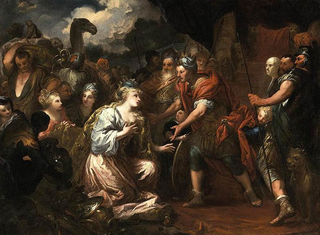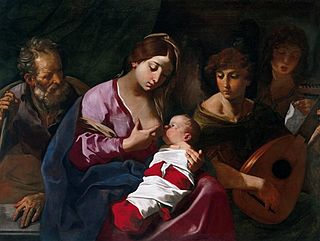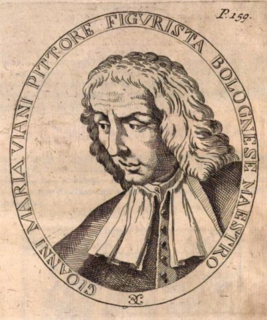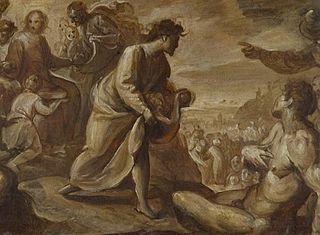
Giuseppe Melani or Milani (13 August 1673 - 7 November 1747) was an Italian painter of the late-Baroque period, active mainly in Pisa. [1]

Giuseppe Melani or Milani (13 August 1673 - 7 November 1747) was an Italian painter of the late-Baroque period, active mainly in Pisa. [1]
His father, Pietro Milani, was a painter. He initially apprenticed with Camillo Gabrielli, a pupil of Ciro Ferri. For the Pisa Cathedral, he painted a Death of San Ranieri. He also painted figures for architectural frescoes, such as the vault of San Matteo (c. 1720) in Pisa, along with his brother Francesco Melani (also an architect, April 7, 1675 -August 21, 1742). [2] Among the pupils of Melani were Tommaso Tommasi, Giuseppe Bracci, Jacopo Donati, Bartolommeo Santini, and Ranieri Gabbrielli. [3]


Giuseppe Maria Crespi, nicknamed Lo Spagnuolo, was an Italian late Baroque painter of the Bolognese School. His eclectic output includes religious paintings and portraits, but he is now most famous for his genre paintings.

Marcantonio Franceschini was an Italian painter of the Baroque period, active mostly in his native Bologna. He was the father and teacher of Giacomo Franceschini.

Camillo Procaccini was an Italian painter. He has been posthumously referred to as the Vasari of Lombardy, for his prolific Mannerist fresco decoration.

Carlo Francesco Nuvolone was an Italian painter of religious subjects and portraits who was active mainly in Lombardy. He became the leading painter in Lombardy in the mid-17th century, producing works on canvas as well as frescoes. Because his style was perceived as close to that of Guido Reni he was nicknamed il Guido della Lombardia.

Santi Prunati was an Italian painter of the Baroque era, born and mainly active in Verona.

Giacomo Boni was an Italian painter of the late-Baroque period, active mainly in Genoa.

Pietro Antonio Rotari was an Italian painter of the Baroque period. Born in Verona, he led a peripatetic career, and died in Saint Petersburg, where he had traveled to paint for the Russian court. His portraits, mostly of women, are renowned for being beautiful and realistic. Rotari's works were generally limited to royal portraits held by notables such as emperors and court ladies.

Aurelio Lomi was an Italian painter of the late-Renaissance and early-Baroque periods, active mainly in his native town of Pisa, Tuscany.

Orazio Riminaldi was an Italian painter who painted mainly history subjects in a Caravaggist style.

Pietro Dandini was an Italian painter of the Baroque period, active mainly in Florence.

Pietro Montanini (1619–1689), also called Petruccio Perugino, was an Italian painter of the Baroque period. He was born in Perugia and first apprenticed with the painter Ciro Ferri, then Salvator Rosa. Among his pupils in Perugia were Mattia Battini and Giuseppe Laudati. His canvas of St Francis Xavier was painted for the Capella Decemvirale in Perugia. Francesco Busti also contributed to this chapel. His nephew, Giovanni Fonticelli, was also a painter.

Flaminio Torre (1620–1661) was an Italian Baroque painter of the Bolognese School, active during the Baroque period.

Giovanni Maria Viani (1636–1700) was an Italian painter of the Baroque period, active in Bologna.
Aureliano Milani (1675–1749) was an Italian painter of the late-Baroque period, active in Bologna and Rome.

Antonio Veneziano, was an Italian painter who was active mainly in Siena, Florence and Pisa, documented between 1369 and 1419.

Giovanni Battista Tempesti (1729–1804) was an Italian painter, active mainly in Pisa.
Giulio Cesare Milani was an Italian painter of the Baroque.
Ranieri Del Pace, also called Giovanni Batista Ranieri Del Pace, was an Italian painter of the late Baroque period, active mainly in Tuscany.
Camillo Gabrielli was an Italian painter of the late Baroque period.

Pietro Sorri (1558-1622) was an Italian painter active in Siena.
| Wikimedia Commons has media related to Giuseppe Melani . |